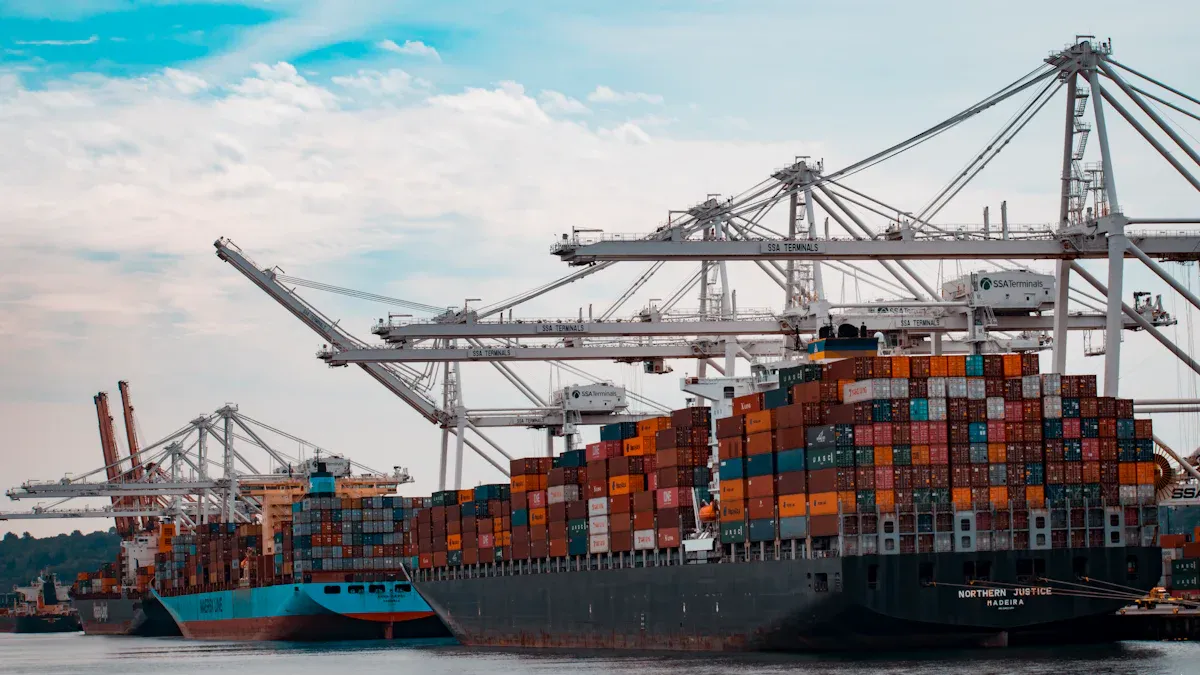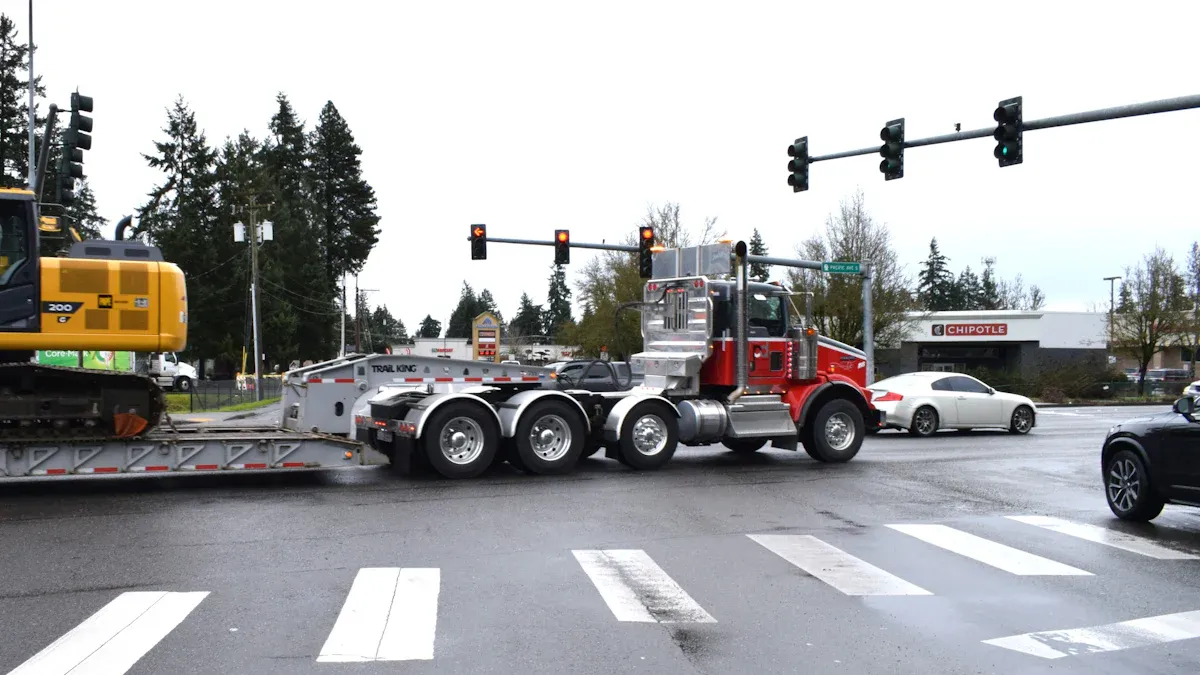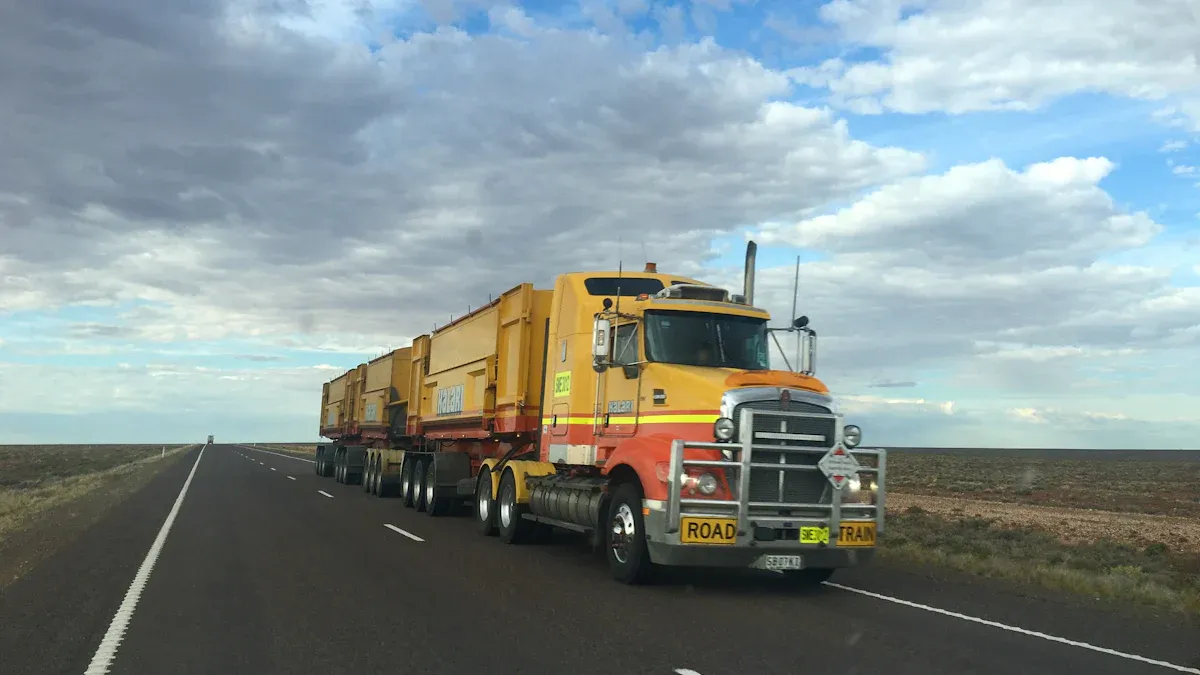How to Manage Oversized Cargo Logistics Efficiently

You can effectively manage oversized cargo logistics by combining precise planning, regulatory compliance, and the right equipment. Oversized cargo includes shipments that exceed standard legal limits, such as loads wider than 8.6 feet, taller than 13.6 feet, or heavier than 80,000 pounds. Efficiently managing oversized cargo logistics is crucial because you face challenges like securing permits, selecting specialized equipment, and coordinating escort vehicles. Careful coordination and adaptability help you control costs, maintain safety, and ensure compliance throughout the process.
Key Takeaways
Perform a thorough cargo assessment to measure width, height, length, and weight accurately. This step is crucial to avoid delays and extra costs.
Select the right equipment and packaging for your oversized cargo. Using suitable trailers and securement methods ensures safety during transport.
Understand and comply with local regulations and permit requirements. This knowledge helps you avoid fines and ensures a smooth shipping process.
Plan your route carefully to avoid obstacles and delays. Consider factors like road restrictions and weather conditions to keep your shipment on schedule.
Maintain clear communication with all logistics partners. Sharing detailed information helps everyone stay informed and ready for each step.
Managing Oversized Cargo Logistics

Cargo Assessment
You start managing oversized cargo logistics by performing a thorough cargo assessment. Accurate measurement is the foundation of a successful shipment. You must record the exact width, height, length, and weight of your cargo. If your load exceeds 8.5 feet in width, 13.5 feet in height, 53 feet in length, or 80,000 pounds, it qualifies as oversized. Each state may have different limits, so you need to check local rules before moving forward.
Tip: Always double-check your measurements. Even a small error can cause delays or extra costs.
Here is a quick reference for standard limits:
Dimension | Standard Limit (Road Transport) | Implication |
|---|---|---|
Width | Over 8ft 6in (2.59 m) | Requires wide-load permits |
Height | Over 13ft 6in (4.11 m) | Requires clearance checks and height permits |
Length | Over 53ft (16.15 m) | Requires length permits and special trailers |
Weight | Over 46,000 lbs (20,865 kg) | Requires overweight permits and equipment |
You also need to document these details. Clear documentation helps you get accurate quotes and ensures everyone involved understands the shipment’s requirements. When you provide complete information, your transportation provider can plan the safest and most efficient route. This step reduces the risk of costly delays and improves the success rate of your delivery.
Preparation Steps
Once you finish your cargo assessment, you move to the preparation phase. This step involves several important tasks:
Evaluate Handling Requirements:
You must know your shipment. Confirm the dimensions and weight to avoid disruptions. Plan ahead to prevent last-minute issues. For very large loads, you may need escort vehicles to ensure safety on the road.Select Suitable Packaging and Securing Methods:
Use strong packaging materials to protect your cargo. Secure the load properly to prevent shifting during transport. For items over 30 kg, extra care is necessary.Choose the Right Carrier and Equipment:
Select a carrier with experience in oversized cargo. Make sure they have the right trailers, trucks, and equipment for your specific load.Prepare All Necessary Paperwork:
Gather all required documents, such as permits, insurance, and compliance forms. Each state or region may require different paperwork. Missing documents can lead to fines or shipment delays.Communicate Clearly with All Parties:
Share all cargo details and special instructions with your logistics partners. Good communication helps everyone stay informed and ready for each step.
Note: Comprehensive planning and risk assessment help you identify potential problems before they happen. Consider factors like route obstacles, weather, and local regulations.
By following these steps, you set a strong foundation for managing oversized cargo logistics. You reduce risks, control costs, and improve the chances of a smooth delivery.
Compliance and Permits
Regulations Overview
You must understand the rules that govern oversized cargo before you move your shipment. Each country, state, or region sets its own limits for size and weight. In the United States, you need to follow local, state, and federal regulations. In Europe, each EU member state has its own rules, but common principles apply. You often need an individual permit for a specific route and time period. Some loads require escort vehicles or even police supervision.
Tip: Always check the latest guidelines before planning your route. Rules can change, and missing a new requirement can delay your shipment.
Here are some key points to remember:
Special permits are required for oversized or overweight vehicles.
You must follow strict safety standards during loading and unloading.
Secure your cargo with locks, straps, and braces to prevent movement.
The angle of loading ramps is regulated to reduce the risk of sliding or tipping.
For air transport, you must align cargo with the aircraft’s bay and maintain balance.
Permit Process
You need to follow a clear process to secure the right permits for your shipment. Missing a step can lead to fines or delays. Here is a typical process for the United States:
Gather all necessary information. You must provide your DOT number, truck and trailer details, a description of your freight, and your transportation dates.
Determine the type of permits you need. Check if your route crosses state, county, or city lines, as each may require different permits.
Obtain the permits. You can get them directly from the governing body or use a permit service to help with the paperwork.
Note: Some extremely oversized loads may need extra steps, such as arranging for escort vehicles or police supervision.
By understanding these regulations and following the permit process, you make managing oversized cargo logistics safer and more efficient.
Equipment and Partnerships
Equipment Selection
Choosing the right equipment plays a vital role in managing oversized cargo logistics. Specialized trailers and machinery help you move large and heavy shipments safely. You can select from several trailer types, each designed for specific cargo needs:
Flatbed trailers work well for large loads that do not need weather protection.
Curtain-side trailers use canvas curtains for easy loading and added protection.
Drop deck trailers offer a lower deck for taller items.
Step deck trailers provide two height sections for different sizes.
Lowboy trailers handle tall and heavy machinery.
Multi-axle and hydraulic trailers distribute weight and adjust height for safe loading.
Extendable and modular trailers fit longer or irregularly shaped cargo.
Self-propelled modular transporters move heavy objects that cannot be lifted.
Specialized equipment prevents accidents and keeps your shipment secure. These trailers are engineered to handle the weight and size of oversized loads. You also need cranes and other machinery for safe loading and unloading. Skilled operators reduce the risk of damage during transit.
Tip: Always match your equipment to your cargo’s dimensions and weight. This step ensures compliance with safety regulations.
Logistics Partners
Working with experienced logistics partners brings many advantages. You benefit from their expert handling, which lowers the risk of damage. They understand complex regulations and help you avoid legal issues. Reliable partners plan routes and coordinate with ports for smooth delivery.
Description | |
|---|---|
Advance Planning and Stakeholder Alignment | Early planning keeps your schedule on track and aligns with site readiness. |
Regulatory Compliance and Permitting | Partners secure permits and follow all laws. |
Terminal Handling and Port Coordination | Efficient unloading at terminals speeds up cargo movement. |
Route Planning and Infrastructure Assessment | Partners check routes for size and weight limits. |
Equipment Selection and Staging | They use the right trailers and equipment for safety. |
In-Transit Monitoring and Communication | Continuous updates help prevent delays and manage risks. |
Site Delivery and Final Checks | Partners inspect sites before offloading to ensure safety. |
Experienced logistics companies use advanced technology for real-time tracking. They offer tailored solutions for unique shipments and optimize costs by consolidating loads. You gain peace of mind knowing your cargo will arrive on time and in good condition.
Route Planning and Monitoring

Route Selection
Strategic route planning is essential when you move oversized cargo. You must avoid obstacles and delays to keep your shipment on schedule. Many factors affect your route choice:
Dimensional and weight restrictions on roads and bridges
Ongoing roadway construction
Timing and cost of required permits
Travel restrictions and curfews in certain areas
Route surveys for clearance and safety
Need for escort vehicles
Seasonal weather conditions
Unique features of each route
If you overlook any of these, you may face common obstacles. These include:
Failing to plan for travel restrictions
Permits expiring without proper planning
Operating with a lack of area resources
Missing permits on sequential project loads
You can reduce risks by planning each detail in advance. Always review your route for possible hazards and confirm all permits before departure.
Tip: Use route surveys and consult with local authorities to identify potential issues early.
Real-Time Tracking
Continuous monitoring during transit keeps your shipment safe and on track. You can use real-time tracking technologies such as GPS, IoT sensors, and live carrier data. These tools give you instant updates on your cargo’s location and status. They help you respond quickly to any changes or delays.
Real-time monitoring improves safety and efficiency in several ways:
Enhanced fleet visibility lets you manage trucks and optimize routes.
Improved delivery accuracy helps you anticipate delays and reroute if needed.
Optimal resource utilization saves costs and boosts profits.
Proactive maintenance management reduces downtime by spotting issues early.
Enhanced safety and compliance ensure drivers follow rules and best practices.
You gain transparency and peace of mind when you track your shipment in real time. This step is vital for managing oversized cargo logistics and meeting customer expectations.
Safety and Contingency
Secure Loading
You must follow strict best practices when loading oversized cargo. Safe loading protects your shipment and everyone involved in transport. Start by assessing your cargo and choosing secure loading techniques. Use the correct securement methods for your specific load. Distribute weight evenly across the trailer to prevent tipping or shifting.
*Best practices for secure loading include:*
Employ secure loading techniques for every shipment.
Assess cargo before loading to identify risks.
Use correct securement methods, such as straps, chains, or braces.
Distribute weight evenly to maintain balance.
Accidents often happen during loading. The most common causes include:
Overloading, which strains the vehicle’s brakes and increases the risk of brake failure.
Unbalanced loads, which can cause the truck to veer or tip over.
Unsecured cargo, which may shift during transit and spill onto the road.
Tip: Always double-check your securement before departure. A quick inspection can prevent costly accidents.
Handling Challenges
Unexpected issues can arise at any stage of managing oversized cargo logistics. You need a strong contingency plan to keep your shipment on track. Work with a carrier that has a reliable network and proven contingency plans. Maintain open communication with your carrier and all partners. Stay flexible and adapt quickly to changes in the shipping schedule.
When you face a challenge, follow these steps:
Start with clear communication and gather information about the issue.
Cultivate strong relationships with your supply chain partners.
Build a solid communications network for rapid decision-making.
Continuous improvement helps you handle future challenges better. Use strategies like identifying problem areas, implementing structured improvement cycles, and integrating technology. The table below shows effective strategies for ongoing improvement:
Strategy | Description |
|---|---|
Identify Problem Areas | Recognize specific challenges to target improvements effectively. |
Structured Improvement Cycles | Make incremental changes and assess their impact. |
Six Sigma and Kaizen | Use these methods to enhance quality and efficiency. |
Technology Integration | Leverage technology to streamline processes. |
Customer-Centric Approaches | Focus on customer needs to improve satisfaction. |
Effective Communication | Ensure clear communication among all stakeholders. |
Note: Train your staff regularly and automate processes where possible. These steps boost efficiency and reduce errors.
By following these safety and contingency practices, you build a resilient operation that can handle the demands of oversized cargo logistics.
You can improve managing oversized cargo logistics by focusing on accurate planning, legal compliance, and using the right equipment.
Industry experts recommend integrating AI and IoT for real-time tracking, secure loading, and route optimization.
Common mistakes include poor route planning and inadequate equipment, which lead to costly delays.
Assess your current logistics processes, set clear goals, and collaborate with stakeholders for continuous improvement.
Explore support from organizations such as the National Customs Brokers & Forwarders Association of America, Airforwarders Association, and Council of Supply Chain Management Professionals to strengthen your logistics network.
FAQ
What qualifies as oversized cargo?
You classify cargo as oversized when it exceeds standard legal limits for width, height, length, or weight. For example, loads wider than 8.6 feet or heavier than 80,000 pounds require special handling and permits.
How do you choose the right trailer for oversized cargo?
You select a trailer based on your cargo’s size, weight, and shape. Common options include flatbed, lowboy, and extendable trailers. Consult your logistics provider for the best match.
Why do you need permits for oversized shipments?
Permits ensure your shipment follows local, state, and federal laws. They help you avoid fines and keep your cargo, drivers, and the public safe during transport.
What should you do if your shipment faces unexpected delays?
Stay in contact with your logistics partner. Use real-time tracking to monitor your cargo. Adjust your plans quickly to minimize downtime and keep your delivery on schedule.
See Also
Key Strategies for Effective Management of Global Logistics
Enhancing International Operations Through Innovative Logistics Solutions
Top Global Logistics Services for Efficient West Coast Trucking
